#SONIC IS SUPPOSED TO BE DRAWN LIKE GOOFY WITH HIS EYES
Explore tagged Tumblr posts
Text

Wait is that it? Let me try

Oh my god I’ve been drawimg sonic wrong the whole time
#sonic the hedgehog#sonic#fan art#WE WERE WRONG#HIS EYES ARE SUPPOSED TO BE DRAWN AS TWO#SONIC IS SUPPOSED TO BE DRAWN LIKE GOOFY WITH HIS EYES#character design
1 note
·
View note
Text
159. Sonic Super Special #15

Welcome to the final Sonic Super Special ever! Here's my opinion on it. Past Super Specials have ranged from okay to amazing, depending on the writer and the subject matter, and their long length has usually, if you ask me, worked in their favor, as it meant more time and space to tell a compelling story. This is not true of this one. Unfortunately, the last super special of the comic is utterly awful, with two stories that do absolutely nothing to grip my attention, one of which ends in a status quo with a net gain of absolutely nothing, and the other of which is cringeworthy and isn't even very clear on when, where or how it takes place. Let's just get this over with, shall we?
Naugus Games
Writer: Ken Penders Pencils: Many Hands Colors: Josh and Aimeee Ray
This first story is far, far longer than it has any right to be - it really feels like they were trying to find ways to pad it out it to take up the full 48 pages of the special. Furthermore, you might notice some oddities about the credits above. First of all, Aimee's name is misspelled with three E's for both stories for some reason, indicating some lazy copy-and-pasting as well as a lack of care from the editors. Even more frustratingly, no one is actually credited directly for the pencils (or inks), with the art instead just being credited to "many hands." Remember how I said the comic was getting annoyingly bad about properly crediting people? Now, in case you're confused, there's not just some artist out there literally named Many Hands; instead, that's the comic's way of sidestepping actually bothering to credit any individuals for their work. It just means "eh, a lot of people worked on this I guess, but we don't care enough to actually tell you who." Unfortunately, unlike a few issues ago where the art style was immediately recognizable as Steven Butler's, the art style for this story is foreign to me, suggesting they got some people who weren't their usual artists to work on this one, so I can't even take an educated guess here. All I know is that both the art style in general and the quality of the inks are very poor, and as we'll see, the art gets unforgivably lazy at times. Perhaps best of all, this story was later retconned into a much more interesting and concise version of itself at a later date, with better storytelling and artwork to boot. The only reason, then, that I'm covering it at all, is honestly as a demonstration of just how lazy the comic could get at times, as well as due to the fact that this is the first appearance of "Many Hands," who later pencilled one other issue for the comic that was of equally poor quality.
So this story takes place at an unspecified time in the recent past. It seems to be sometime after Eggman's return, judging by some of the lines of dialogue within the story, but the actual timeframe is pretty vague. Sonic has returned to the Southern Tundra to pay his respects to Eddy, recalling how Eddy sacrificed himself when he, Tails, and Nate all fought Naugus here some time ago. He's brought a single rose to lay on the site of the wreckage, but the ground isn't quite stable…

And here we have the first instance of a truly terrible art decision. Sonic falls into a pitch black cave system, but instead of representing this with maybe one page max of blackness or darker lighting, we're treated to nearly four pages straight of nothing but this:
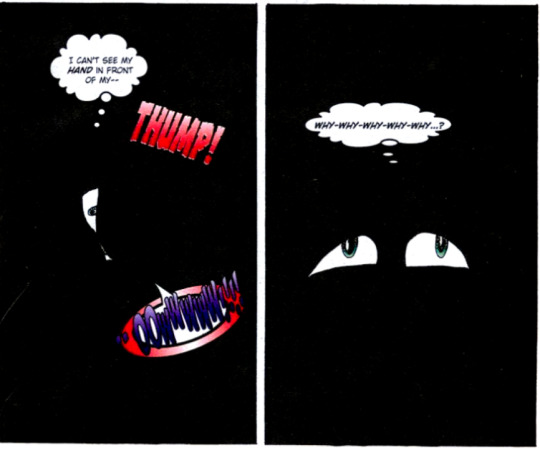
He blindly stumbles around for a while, informing us of this fact through dialogue bubbles because everyone knows that telling is better than showing in fiction, right? He finally hits a wall and sees a glow through a crack in it, so he tunnels his way into the next room only to find it full of glowing rings - apparently, either he, Tails and Naugus somehow didn't use up all the rings when they fought, or these one have just auto-generated themselves somehow down here. Sonic recalls memories of the previous battle when Nate sealed Naugus away with a wish from a ring, and then decides to try to use one to get out of the cave system.
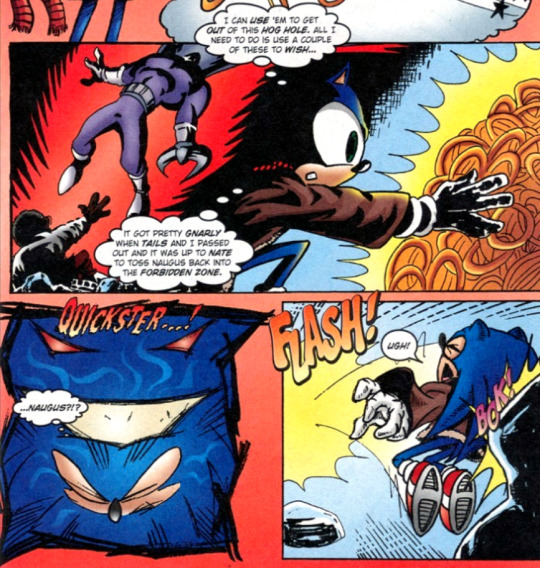
Wonderful! Apparently, a "wish" as defined by the magic of the rings just means that you think of someone's name while touching a ring, and so with a flash, Naugus is back from his imprisonment in the zone that Nate sealed him into! But how is this possible?

That explanation makes… basically no sense, dude. Naugus was definitely sealed away in another zone, he didn't just get turned into a pile of telepathic rings. But whatever. He and Sonic start battling it out, and somehow make it outside, where Naugus conjures up a snowstorm that consistently stays centered on Sonic no matter where he runs. Time for the second awful art choice of the issue - now instead of four pages of pure blackness, we get six whole pages of this:

I think the best thing about this is that the blizzard backgrounds are clearly not even hand drawn like the rest of the comic is - there's only two types of snowflakes up there, and they're consistently just copied and pasted in that same repetitive swirl pattern on every single page. I get that drawing for a big story in a super special like this can be long and tedious work, but this is why you don't try to find a way to artificially elongate a story like this which could easily be told in the span of a normal issue length. It just ends up making the audience feel like their time is being wasted. Anyway, the blizzard finally ends when Sonic pulls out a ring from his jacket and wishes for Naugus to be sealed away in his previous zone once more, and thus, Naugus is out of our hair again, with absolutely nothing to show for it. Man, if it's this easy to defeat people in this universe, why hasn't anyone tried this on Eggman yet?
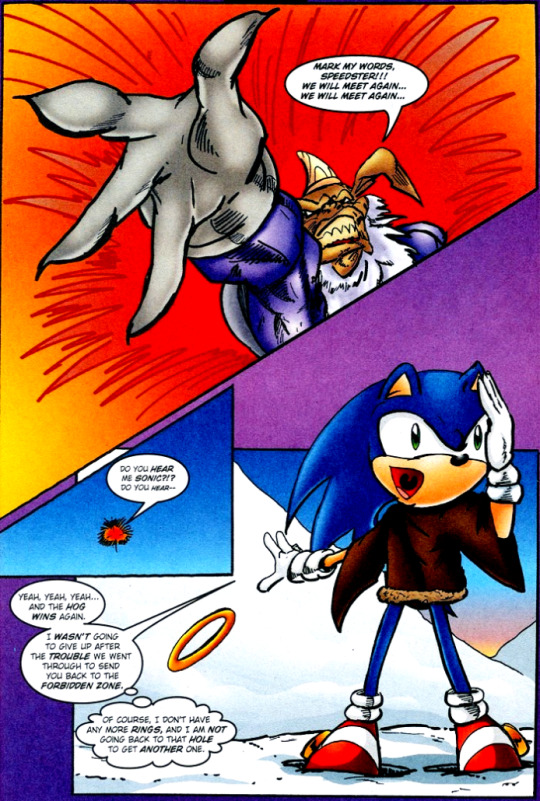
Sonic then leaves back for home, thinking one last time of Eddy, who is shown looking down on him from the heavens above. And thank god that story is over.
Sonic Spin City
Writer/Pencils: Michael Gallagher Colors: Josh and Aimeee Ray
Michael Gallagher, over the course of the comics, has gone from one of the series' main writers to basically a guest writer who's brought on every once in a while for special occasions. In this case, he even makes his return as a penciller! Unfortunately, his goofy writing style has begun to clash with the much more serious plots of these later issues, and this story is no exception. It's entirely unclear about whether we're supposed to take this story as actual canon, as a story from an alternate zone, or as just a silly joke story that doesn’t mean anything - and while I tend to try to avoid looking at non-canon materials in this review series (I've already skipped a few stories and issues for exactly this reason), the ambiguity of this one forces me to cover it. In addition, I don't even know why Josh and "Aimeee" were credited as colorists for this story, considering the entire thing is black and white with no color to be found.
Much like the first story of StH#52, this story has the flair of an old detective serial. Sonic is wandering the streets on a rainy night when two swatbots ambush him. Of course, two swatbots are no match.
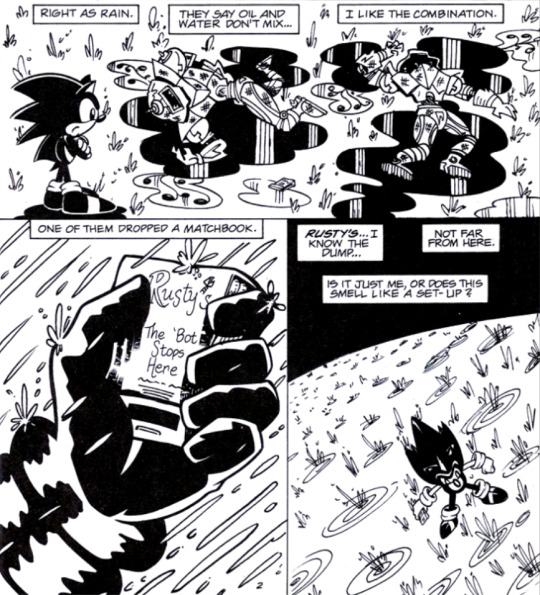
What does a swatbot need matches for? Eh, whatever. Sonic races over to Rusty's, a hangout for abandoned badniks, and orders himself a "chili dog float," which in addition to sounding absolutely disgusting doesn't even seem like something a bar for robots would serve in the first place. As he takes his seat, the lights go out, and… this abomination emerges onto the stage.

Yes. The badniks are going wild for a swatbot with tits dancing seductively on a stage for them. What is she gonna do, plug them into a wall outlet? They even start screaming out for "the stretch," and appear to get even hornier as she massively elongates her legs for them. I mean, just, what? I swear, Michael, if we get one more weird borderline-sex thing like this from you in this comic, my eyes are gonna pop out of my head like Natsuki. A bot grabs the dancer's ankle, and she's thrown off balance and crashes down, with the head popping off to reveal that underneath, it's Bunnie in disguise.
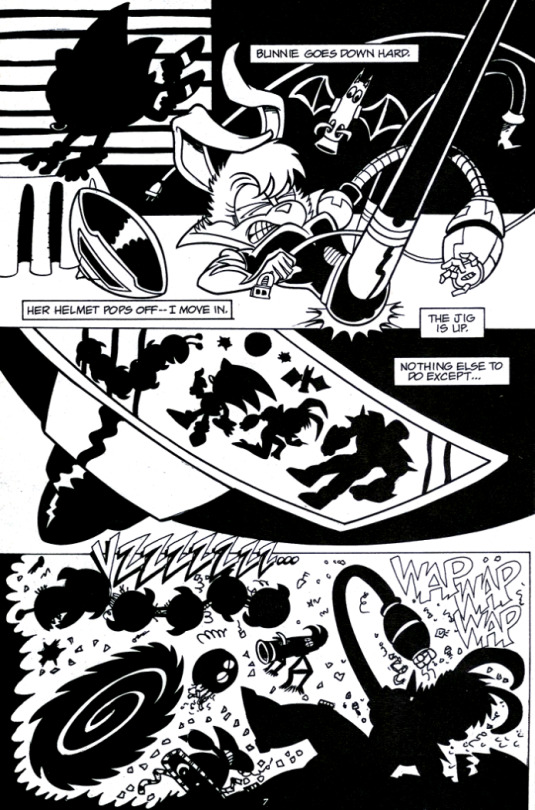
You know, after her claim all those issues back that she's a "sax cymbal," I'm not even gonna contest the idea that she'd do a sexy dance during infiltration for a mission. Hell, I get the impression she'd do one anyway just for fun back in Knothole if she got the chance. You might also notice her arm is the arm from her old design, and that coupled with Sonic's own design seems to indicate that if this took place at all in actual canon, it was before Eggman's return, though I'm immensely skeptical that this is supposed to be canon at all. Sonic and Bunnie take out the rest of Rusty's customer base, and then evacuate before the last swatbot activates its self-destruct chip, blowing the place sky high. Congratulations, nothing important was accomplished in this issue and nobody cares!
It's kinda sad that the final Sonic Super Special turned out to be so low-quality, honestly. However, this marks a bit of a turning point in the comic. For the first time in its entire run, from now on, there are no more special issues, no sister series, no miniseries, nothing. From the next issue, all the way to almost the 200th, with one exception in the form of a Free Comic Book Day issue, there are absolutely no interruptions from issue to issue. While this may not seem too notable at first, since we've just been reading everything in mostly-chronological order anyway, keep in mind that as far as the comic is concerned we're still in the year 2000, with a mere seven years having passed from the beginning of the comic all the way to now over the course of 159 issues. Over the course of the next 106 issues, we're going to blaze through nine years of comic history, meaning that the story is going to flow a lot faster, with more plot points being covered in a shorter amount of time. While this does make the order of issues a lot easier to follow, since there's no questions about which issue fits in where or anything, I am sad to see all the special issues go, as I quite enjoyed how they served to break up the flow of the comic as a whole with special stories and side content. Though we're still in the middle of our current plot era, we're entering into a new era of the comic as a whole, where we've got a straight shot through the next hundred issues. So I say - let's do it to it!
#nala reads archie sonic preboot#archie sonic#archie sonic preboot#sonic the hedgehog#sonic super special 15#writer: ken penders#writer: michael gallagher#pencils: many hands#pencils: michael gallagher#colors: joshua d ray#colors: aimee r ray
3 notes
·
View notes
Text
What is a Hero? A One-Punch Man Analysis

I’ve made no secret of my respect for One-Punch Man and its fairly recent but profound fixture in the cluttered world of modern anime. This senin send up to the shonen superhero genre - born from the unsteady hands of creator ONE as a webcomic nearly a decade ago - initially appeared as nothing more than a poorly drawn gag manga, and even its most stalwart fans often balk at providing a detailed explanation on why it got so big, so fast. What is it about this bland, bald protagonist in a goofy costume and his zany cast mates that strikes such a chord with so many people - some who’d be the last to call themselves anime fans?
Of course, there’s the obvious draw of a new massively powerful, near-invincible character fans can add to their roster of titans - a cudgel with which to play out their vicarious power fantasies. There’s no end of the toxic hate flung about the Internet whenever someone innocently (or not) asks, “Who would win in a fight between Saitama and [X]?” - with “X” being anyone from Goku, to Superman, to God himself. While amusing in a train wreck sort of way, these pissing contests don't help us understand the wider appeal of the series - and in either case miss the point entirely. One-Punch Man has been called everything from a gag series to deconstructive satire - usually by people with little understanding of what these terms really mean.
In fact, One-Punch Man nimbly straddles quite a number of genre lines - partly because ONE didn’t have a solid sense of direction after his crudely drawn webcomic found a bigger audience than he anticipated. But the series rides on thanks to his skills as a storyteller, particularly where he manages to maintain a compelling story arc without losing sight of the absurdity of his premise - letting his fans in on an extended joke even as he (seemingly) plays typical shonen conventions straight at times.
The crucial figure in this tightrope dance is Saitama himself, and ONE expertly uses him to pivot the fraught nexus of literary deconstruction and reconstruction: the dismantling of literary archetypes by exploiting the real-world implications and consequences of their outlandishness; and the more difficult task of rebuilding them into something a bit more solid and more resilient to both past and future critiques.
A Hero Shall Lead Them...
A good place to start is with the the idea of the shonen hero and what he represents. In these series the main protagonist is usually the central focus. True, he (and it's almost always a he) may get eclipsed every once and awhile by another character due to creator preferences or fandom response, but it's still his actions driving the plot, and his growth keeping our butts in the seat. To accomplish this and keep our interest, it’s usually necessary to endow him with some standout feature: good looks, a sad backstory, a drive towards an impossible dream, or just plain, simple badassery.
...Or not
Saitama’s got precious little of any of that. On the surface, he’s a vanilla, rather boring protagonist - dull, plain-looking, and lacking any semblance of motivation or ambition besides “having a good fight.” He doesn’t have a particularly tragic backstory, or any other issue that isn’t, in some way, of his own making. He even falls a bit short in the “badass” department, since unquestionable power and ability aside, he’s too low-key and lazily efficient to capture the attention of his in-universe protectorate. Despite his phenomenal powers and obscene strength, despite his status as the main character, there’s nothing about Saitama that really stands out - at least, not in the way most audiences expect from a shonen hero. He defies our assumptions about what a hero is supposed to look and act like. But what makes this a brilliant twist instead of a recipe for tedium is the reason why Saitama obtained his unbelievable power. No mutant bite, no phenomenal superpowered lineage; he's just a guy who trained so hard that he accidentally became the strongest being in the known universe. If you think that sounds utterly ridiculous, well, you’re right - and you’re not alone; several characters in story aren't drinking his Kool-Aid, either. But the consequences of his current state is where the real fun lies. Saitama paints the picture of the quintessential shonen hero during his training - striving to be the strongest, pushing his body to the limits, and stopping at nothing to fulfill his goal. And guess what? He succeeds. The boring battles, easy victories, and existential ennui that defines and constrains Saitama is merely the end result of what happens when our shonen heroes take “wanting to be the best” to the logical conclusion. Saitama woke up one day and found that he really was the strongest guy around - and without the convenient serial escalation of threats that’s such a hallmark of every other series of this kind, he can do nothing but mourn the lack of any challenge to his unwanted supremacy.
Heroes, Inc.
Saitama’s blandness stands out all the more because he is surrounded by so many colorful characters who to varying degrees of sincerity strive to reach the pinnacle of heroic gestalt. Unfortunately, that amounts to all of jack squat in this world. Heroism is less a service to mankind or a motivator to help the helpless than a stepping stone to stardom, a way to blow off steam, or just a simple paycheck in the mail. The Hero Association who employs most of these “heroes” is a shady and slightly corrupt organization, warping the concept of heroism into some bastard offspring of a numbers game and a popularity contest. Many of the Association's cronies are apathetic to all but their names headlining the front page news, and even those who shun the limelight tend not to hold heroism in the most ideal light. Genos, our hero’s faithful cyborg Number Two, is a perfect example of this, especially in the beginning: the call to heroism had little appeal to the intense, vengeful youth, and even after joining the Association, he cares nothing for the hero culture it brands and advertises. Not that you can blame him; One-Punch Man lifts the veil on what happens when heroism becomes a commodity - much like My Hero Academia at times, but with neither that show’s affirming narrative of striving for your dreams, nor its generally upbeat framing of heroic actions through the eyes of idealistic youths.
The Breakdown of the Ideal Hero
All of the above combine to drive home the deconstructive aspect of the series. In the One-Punch universe, heroism is a public relations racket, meant to boost your social capital or that of the association who hires you. Those few who sincerely wish only to save other people often find themselves overwhelmed by powerful foes and unappreciated by an ungrateful populace. And when Saitama - a genuine powerhouse who, despite his laziness, does believe in the call to protect and serve - shows up and makes everything look so damn easy, both his fellow heroes and the people they watch over have a hard time believing he’s anything but a fraud.
At play here, then, is a fracturing of two of the most dearly-held beliefs of the shonen superhero genre: that pursuing power with single-minded focus - even if for the right reasons - will somehow make your life easier or better, and that being a hero is a noble calling that carries its own rewards. The following example shows just how ruthlessly One-Punch Man can grind down the above “logic” over the course of its run.
Case study: The Deep Sea King
The Deep Sea King Arc (for anime viewers, episodes 9 -10) is a narrative turning point in what had been up to that point a largely episodic gag fest. Besides giving us the series’ first persistent threat to actually cause a significant degree of damage to both the image of the Hero Association and the heroes themselves, this arc also established several trends that come back to wallop the shonen enterprise at many points during the show’s run. For one, we have the introduction and development of multiple heroes, each given a chance to shine and show how deadly they would be if they were up against any normal foe. Stinger, Lightning Max, Snake Fist Snek: all members of the Hero Association’s Class A, the second strongest; all laying out their well-earned hero cred, either here or in previous episodes. And all fall to the Deep Sea King with little or no effort. It only escalates from there: Speed-o'-Sound Sonic, One-Punch Man’s resident ninja and self-proclaimed rival to Saitama, fails to inflict any lasting damage on the brute. As does Puri Puri Prisoner, the first S-Class (the best of the best in the Association) we see in action besides Genos, despite a rather impressive showing. Even Genos himself gives a strong if futile effort against the evil beast, accustomed as he is to getting ragdolled in order to make the monster of the week look more dangerous before Saitama fists it to oblivion.
So far, this all still follows the standard shonen patterns: evil enemy appears, carves a bloody swath through a line of lesser heroes, and eventually stumbles into a final showdown with our protagonist. Even so, One-Punch Man still has time to play with a few genre archetypes along the way to varying degrees of faithfulness: the power of teamwork, which fails miserably; the heroic transformation sequence, which only serves to show a side of Puri Puri Prisoner most of us definitely did not want to see; and even the infamous “nakarma power up,” during which resident low-ranked muggle hero Licenseless Rider gains a second wind in his hopeless battle against the Deep Sea King because the crowd he’s protecting all rallied behind him...which does absolutely nothing to change the outcome in any way. It's at this point - with all the shonen-trope fish riddled with bullets at the bottom of the barrel - that Saitama finally steps in, annoyed and ready to throw down with the king.
By now, most fans probably know the deal - but those few who miraculously missed the memo on what this series is all about might be expecting a decent fight for once. And were this any other series, they’d have every right to. Years of shonen narrative archetypes have conditioned us to expect a fight in these circumstances- maybe one-sided, maybe back- and-forth, but still, a fight. What we get was the usual half-assed, one punch victory; Saitama drops him like an afterthought, just like every other baddie on the show. But it is the crowd’s reaction and what follows that really twists the deconstructive knife. Saitama’s hilariously effortless dispatching of the Deep Sea King is par for the course for him, but completely throws his spectators for a loop- so much so that one particular ingrate uses it to argue against the efficacy of the Hero Association and heroes in general.
For most fans, this venom-spewing cretin should be burned in effigy. But his arguments, on closer inspection, don't deviate much from the tirades shonen fans often level at “weak” characters in many franchises. He questions the strength and usefulness of heroes and the hero ranking since a low-ranked nobody like Saitama can come along and end it in a single punch. Truth be told, he does have a point about the rankings' unreliability, but when he equates strength with heroism, thus casting all the heroes who risked everything to keep him and his fellow citizens safe into the proverbial waste bin, he’s not saying anything out of the ordinary for fandoms like Dragonball or One Piece, where “weak” characters are often the butts of many jokes for the sin of not being in the top power tier.
What's at heart here is the very nature of heroism itself, and who gets to define it. Our obnoxious jerk lays out his own understanding: “Anyone can buy a little time, but a hero has to beat monsters.” With that, the heckler shows his shared lineage with those who lust after the violent anti-hero archetype - the ones, like Saitama in the beginning, who are motivated more by the thrill of a good fight than a desire to save people. These are the heroes who stop at nothing to “beat the bad guy” - collateral damage, protecting innocents, or a sense of higher purpose driving their actions be damned. These are the heroes who own a dominant share of the current shonen market and who power the 90s Anti-hero trope so well known in Western comics. These heroes, and their fans, hold “badassery” as the most important and defining trait a hero can have, giving lift to the most reprehensible personal and moral views so long as they have what it takes to annihilate the enemy and confer bragging rights to their vicarious backers.
Tear Down, Build Up
There are many other instances like this all throughout ONE’s webcomic and especially the fabulous redrawn manga made in collaboration with the great Yusuke Murata. Teamwork among these heroes is seen not only to fail, but to be fundamentally flawed when weighed against the egos and relative powerlessness of the parties involved. The Hero Association gets rattled a few more times over the course of the series - each time revealing an even more unsavory underbelly in the process. Perhaps the darkest manifestation of One-Punch Man’s deconstructive digs is Handsomely Masked Sweet Mask, the Association’s top A-Class and unofficial gatekeeper to the coveted Class S. Popular, charming, and incredibly handsome, Sweet Mask harbors an almost sociopathic degree of black and white thinking. His main quirk - aside from badgering other heroes for not living up to his ideals of “perfection” - is his relentless desire to vanquish “evil,” however he sees it. This isn’t new, of course; hero teams across genres and cultures often have at least one moral monster to wreak havoc with the series' karmic tilt. But ONE keeps true to his ironic bent by showing how flat-out insane it looks from the outside to idolize someone like that. Sweet Mask will disregard orders to bring a target in alive, threaten other heroes and even children who dare interfere with his directives, and all the while his fans cheer him on because hey, he looks so damn good doing it. This creep's in-universe fandom love him for all the most shallow reasons, and though most of us in real life are thoroughly repulsed by him (if the tremendous amounts of hate he gets across the Internet is anything to go by) Sweet Mask slyly reveals the many illogical ways we justify flocking to characters that intrigue us superficially, even as we’d find their behavior under any other circumstance - or even if enacted by a less attractive or "cool" character - repugnant.
One-Punch Man, far from being a simple gag series, runs quite a few deconstructive currents under the smooth surface of in-jokes and silliness. Sure, it’s no Voltaire or Jonathan Swift, but ONE’s crafting has more than a little method behind the madness. Indeed, you might be forgiven for assuming that the series is primarily satire - a brutal poke at the superhero premise specifically and anime archetypes generally. But there’s another side to the story; just as the little creep in the Deep Sea King Arc made his case of what a hero is supposed to be, Saitama himself had his own answer. And we’ll examine that in depth in the next part, along with the slew of other gems ONE throws in to veer his series away from simply demolishing fictional heroism’s house of card and towards rebuilding it in (partial) glory.
2 notes
·
View notes